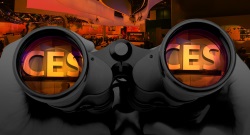BY CHRISTOPHER CAEN
Theory Associates
www.theoryassociates.com
In politics, there is something called “opposition research.” This is where your team goes out and digs out all that lovely negative background information on your opponent so you can then drag them through the mud to certain doom. However, “opp research” also serves a more subtle purpose, a method to understand how your competition is talking to your audience, what they think is motivating them, and how they are trying to position you in return.

When done well, opp research decodes the brain of your opponent, and makes defending your messaging that much easier. And the same can be said of brands. They too can be decoded, broken into their elemental pieces, and then countered efficiently. And on the floor of a trade show with 160,000 attendees, it becomes that much more important.
So what should you be looking for as you build and defend your messaging and branding for the show? You are looking primarily for three things.
First off, you want to see if there is a shift in the messaging or how your competitors are positioning themselves. Right now, companies are starting to leak out any new positioning in advance of the show. The reason is this is dovetailing with their PR minions emerging from their bunkers to start setting up media and interview hits during CES. Is there a new tagline? A new slogan? Does it seem like their target audience has shifted? You should be aware of all of this heading into the show, because the last thing you want is a microphone in front of you, a question about the competition, and no ready answer at hand.
The next issue at hand is the new product launches from other companies. Usually by the time the show rolls around, everyone has a pretty good idea of what is going to be popping out the door come January. However, how this affects you has to be assessed, and then recast into the market. Does a competitor have a new piece of technology? You may need to figure out a way to counter that. A new category they are entering? You have to decide if this is relevant to you or not. And if they are launching a new type of product, how does this define you? I am sure that Olympus, Canon, and Nikon gave a collective yawn when GoPro first launched, not realizing their entire market was about to get redefined around them. Most importantly, when you do have your response figured out, you have to make sure everyone in your company knows the talking points, from your CEO in the executive suite to the marketing assistant manning the booth on the floor.
The last issue is the brand itself. A new logo is an obvious poker that tells that something is afoot at the competition, but often the signs are more subtle than that. Has the look and feel been upgraded on their website? They may be trying to go up or down market on you. Are they sporting new corporate graphics? Their voice and how they communicate to their audience could be getting a refresh. Has the packaging suddenly altered? Often if they are entering a new part of the market or introducing a new product segment, the entire packaging line may visually reset to accommodate that shift. Regardless, if there is a fresh look, you are probably going to get a face full of it on the floor of the show. Your current booth graphics may indeed be fine as they are, but be aware that you may wind up looking old and dated if you don’t keep an eye around you.
Markets are dynamic, changing beasts. At this show, more than any other, every one is trying to redefine their markets in their own image. Your challenge is to understand these pressures before you go in, and then be able to defend your brand and your messaging against this assault. Done well, you will be positioned perfectly for the rest of the year. Get it wrong and, well, here’s a GoPro for you.
Advertisement





